Many websites and services offer Two-factor authentication (2FA) which you should be using. Two-factor authentication (2FA) adds extra security to your online accounts and systems, going beyond just a password. It requires users to provide two separate pieces of evidence to verify their identity when accessing an account or system. Here’s why you should be using two-factor authentication:

Enhanced Security
Passwords can be easily compromised through hacking, phishing, or other means. Two-factor authentication adds an additional layer of security by requiring something the user knows (password) and something the user has (usually a temporary code or physical device), making it much harder for unauthorized individuals to access an account.
Mitigating Data Breaches
Even if a hacker gets your password from a data breach, they can’t access your account without the second authentication factor.
Phishing Protection
Traditional phishing attacks often rely on tricking users into revealing their passwords. With two-factor authentication, even if a user falls for a phishing scam and enters their password, the attacker would still need the second factor to gain access.
Credential Stuffing Prevention
Some attackers try to use previously stolen username and password combinations on various websites to see if they work. Two-factor authentication adds an extra layer that prevents this method from being successful.
Mobile Devices as Authentication Factors
Many 2FA implementations use mobile apps or SMS codes as the second factor. Since most people carry their phones with them, this adds a level of convenience to the authentication process.
Secure Remote Access
For businesses and organizations, two-factor authentication can be especially important for remote access to sensitive systems. It ensures that even if an employee’s password is compromised, unauthorized individuals can’t easily gain access to company resources.
Compliance Requirements
In certain industries, regulations and compliance standards require the use of strong authentication methods like 2FA to protect sensitive information.
Peace of Mind
Knowing that your accounts are more secure can provide peace of mind, especially in an age where cyber threats are prevalent.
Easy to Set Up
Many online platforms and services offer two-factor authentication options that are relatively easy to set up. It’s a simple step that can greatly enhance your account’s security.
Future-Proofing
As technology evolves, hackers become more sophisticated. Implementing two-factor authentication can help keep your accounts secure against new and emerging threats.
2FA significantly improves security, but it’s important to note that no system is completely foolproof. It’s still crucial to follow best practices for cybersecurity, such as using strong and unique passwords, keeping your devices and software up to date, and being cautious of phishing attempts.

Possible Downsides
While two-factor authentication (2FA) offers enhanced security, there are also some potential downsides and considerations to keep in mind. Depending on the implementation, 2FA can introduce additional steps to the login process, which might be seen as cumbersome by some users. For example, having to enter a one-time code from a mobile app or wait for an SMS can slow down the login process. If your second factor of authentication relies on a physical device or service (such as a smartphone app or SMS), you may encounter issues if you lose access to that device or if the service experiences downtime. This could lead to being locked out of your accounts. The recovery process can sometimes be complex and require contacting customer support if you lost your device. It’s crucial to set up backup methods or recovery codes where available. While 2FA helps mitigate phishing attacks, sophisticated attackers could still attempt to trick users into providing both their password and the second factor. This highlights the importance of educating users about phishing tactics.
Despite these potential downsides, the benefits of using two-factor authentication generally outweigh the drawbacks in terms of security. It’s important to carefully consider the specific two-factor authentication methods available and choose the ones that align with your security needs and usability preferences. Additionally, combining Two-factor authentication with other security best practices, such as regular software updates and strong password management, can further enhance your overall security posture.
Stay Informed and Stay Thriving!
InsideOut Solutions creates a new blog post every week, so subscribe to our monthly newsletter to stay updated with our recent blog posts! Don’t hesitate to reach out if you have any questions or need assistance with your two-factor authentication. We’re here to help!
